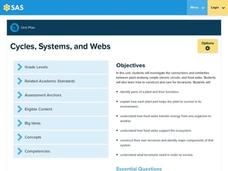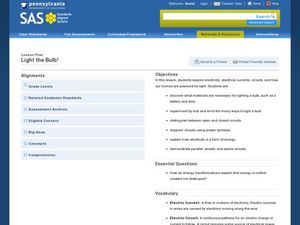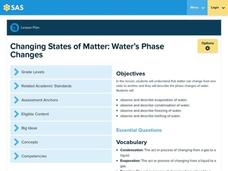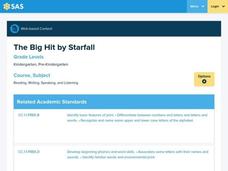Pennsylvania Department of Education
Volume of Regular and Irregular Objects
Fifth graders examine patterns and relate to equations to solve math problems. In this patterns lesson, 5th graders diagram, graph, use models and use tables to solve equations for real world problems.
Pennsylvania Department of Education
Volume of Compound Figures
Fifth graders use patterns, models and relationships to solve equations. In this equations lesson, 5th graders define vocabulary for equations and complete worksheets explaining variables and solving problems.
Pennsylvania Department of Education
Use Order of Operations to Evaluate Expressions—No Grouping Symbols
Students identify and explain different types of data collection and graphs. For this graphs and data collection lesson, students record their observations of a variety of data collection tools and graphs displayed in the room. Students...
Pennsylvania Department of Education
Cycles, Systems, and Webs
Fourth graders review the parts of the plant and their functions. In this plant lesson plan, 4th graders recognize that plants must transfer energy to make food. Students understand the interdependence of organisms in an ecosystem.
Pennsylvania Department of Education
Light the Bulb!
Third graders investigate electrical circuits and how light bulbs are powered. In this electricity and power activity, 3rd graders study the vocabulary necessary which includes the different types of circuits, electrical currents, and...
Pennsylvania Department of Education
Using the Coordinate Plane in Problem Solving
Fifth graders practice solving problems. In this fraction and decimal lesson plan, 5th graders recognize the relationship between fraction and decimals. Students estimate problem results and write expressions to use for problem solving.
Pennsylvania Department of Education
Equal Groups
Students explore statistics by completing a graphing activity. In this data analysis lesson, students define a list of mathematical vocabulary terms before unpacking a box of raisins. Students utilize the raisins to plot data on a line...
Pennsylvania Department of Education
Multiplication Represented as Arrays
Third graders collect data about themselves and use in a line plot. In this analyzing data instructional activity, 3rd graders collect various sets of information,create a line plot and compare the data. Students complete a worksheet on...
Pennsylvania Department of Education
A Geometric Scavenger Hunt
Fifth graders connect their knowledge of polygons and polyhedrons. For this geometric shapes lesson, 5th graders identify and classify two- and three-dimensional objects. Students construct a polyhedron out of polygons and describe their...
Pennsylvania Department of Education
Animal Classes and Their Ecosystems
Students explore animal characteristics by participating in an environment identification activity. In this animal habitat lesson, students discuss a range of different wild life and the ecosystems that they are a part of. Students view...
Curated OER
Weather, Climate and Atmospheric Process
Students explore Earth science by completing a could identification activity. In this weather lesson, students discuss the different forms of measurement for the weather of Earth. Students discuss global warming and examine a list of...
Pennsylvania Department of Education
The Digestive System
Fourth graders simulate how the digestive system works. In this hands-on simulation, 4th graders complete six group activities that help students visualize how our body breaks down food into nutrients.
Pennsylvania Department of Education
Changing States of Matter: Water’s Phase Changes
Third graders observe the properties of water and in its different states. For this states of matter lesson, 3rd graders view a video, read The Magic School Bus at the Waterworks and experiment with freezing, melting and boiling water to...
Curated OER
Build Your Own Submarine
Students construct their own submarine following a certain procedure. For this physics lesson, students calculate the density of objects using a mathematical formula. They explain why some object floats in water while some do not.
Curated OER
Areology-The Study of Mars
Students examine core samples from Mars and discover what they can use it to tell the history of Mars. In this core sample lesson students create and analyze their own core samples then eat them at the end.
Curated OER
Investigating Planetary Soils
Students study soil characteristics and identify properties of soils from different parts of the solar system. In this soil instructional activity students divide into groups, read soil descriptions, test and record soil samples.
Curated OER
The Space Cadet's Laboratory: Using Electromagnetic Energy to Study Astronomy
Students build their own spectrophotometer to study light. In this physics lesson plan, students explain the dual nature of light. They calculate the angle of incidence and refraction using Snell's law equation.
Curated OER
How to Inspire the Young Inventors in Your Classroom
Learning about inventing and innovation can be exciting and empowering for all students.
Curated OER
What Are You Going to Be for Halloween?
I love Halloween! Use the holiday to spark conversation with your youngsters. They practice asking and answering questions, recording answers on the sheet provided.
Curated OER
Peg and Hen
Learners navigate a website to practice the short e sound. In this short e sound lesson, students read a story on Starfall and complete practice with the short e sound.
Curated OER
The Big Hit
Students are introduced to the phonetic sound associated with the short letter "i" and listen to a story which includes words with this sound. For this the big hit starfall lesson, students build sound letter accuracy. Students also...
Curated OER
Shape Tool
Students explore various polygons and examine how shapes can be manipulated in a variety of ways. In this shape tool lesson, students identify geometric shapes in two dimensions. Students identify and draw one line of symmetry in a...
Curated OER
Pan Balance: Shapes
Students explore the concept of equivalence as it relates to comparing concrete objects to determine greater or lesser attributes such as length and weight. In this pan balance-shapes instructional activity, students make estimations...
Curated OER
Bobbie Bear
Students examine how many different outfits can be made out of a given set of different colored shirts and pants. In this word problem lesson, students list or graph the possible results of an experiment. Students make a list of all...

























